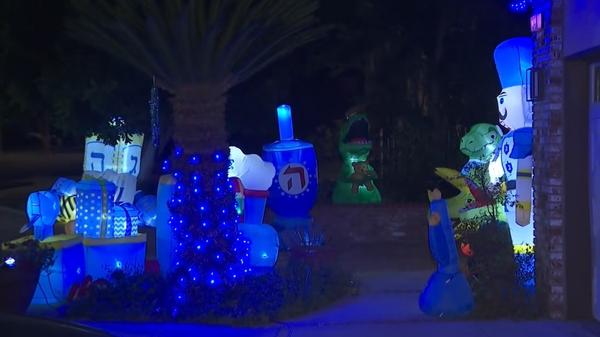
Summer is here, and with it comes glorious sunshine. As well as keeping your vitamin D levels topped up, the sun can be a free source of off-grid power for your gadgets. If the thought of your smartphone dying mid-hike or your Bluetooth speaker conking out at a festival fills you with dread, you might need a solar charger.
While traditional rooftop solar panels are designed to power everything from your washing machine to your air conditioner, the portable kind are all about keeping your essentials juiced up when you're far from a plug socket. Adding a portable power station makes solar chargers even more useful, letting you collect enough electricity during the day to keep an off-grid shed, stables, garage or campsite illuminated after dark. Many of the solar chargers on my list have accompanying power stations, though these are considerably more expensive than the panels themselves.
No matter how you use them, the best portable solar chargers are impressively compact, lightweight and surprisingly good at drawing energy from the sun. Many are designed with hiking and camping in mind, folding down small enough to slip into a backpack or hang off it while you trek, while some are made specifically to keep car and boat batteries from going flat when not in use.
With so many potential uses and pitfalls, I tested a range of solar chargers to find the very best.
How I tested
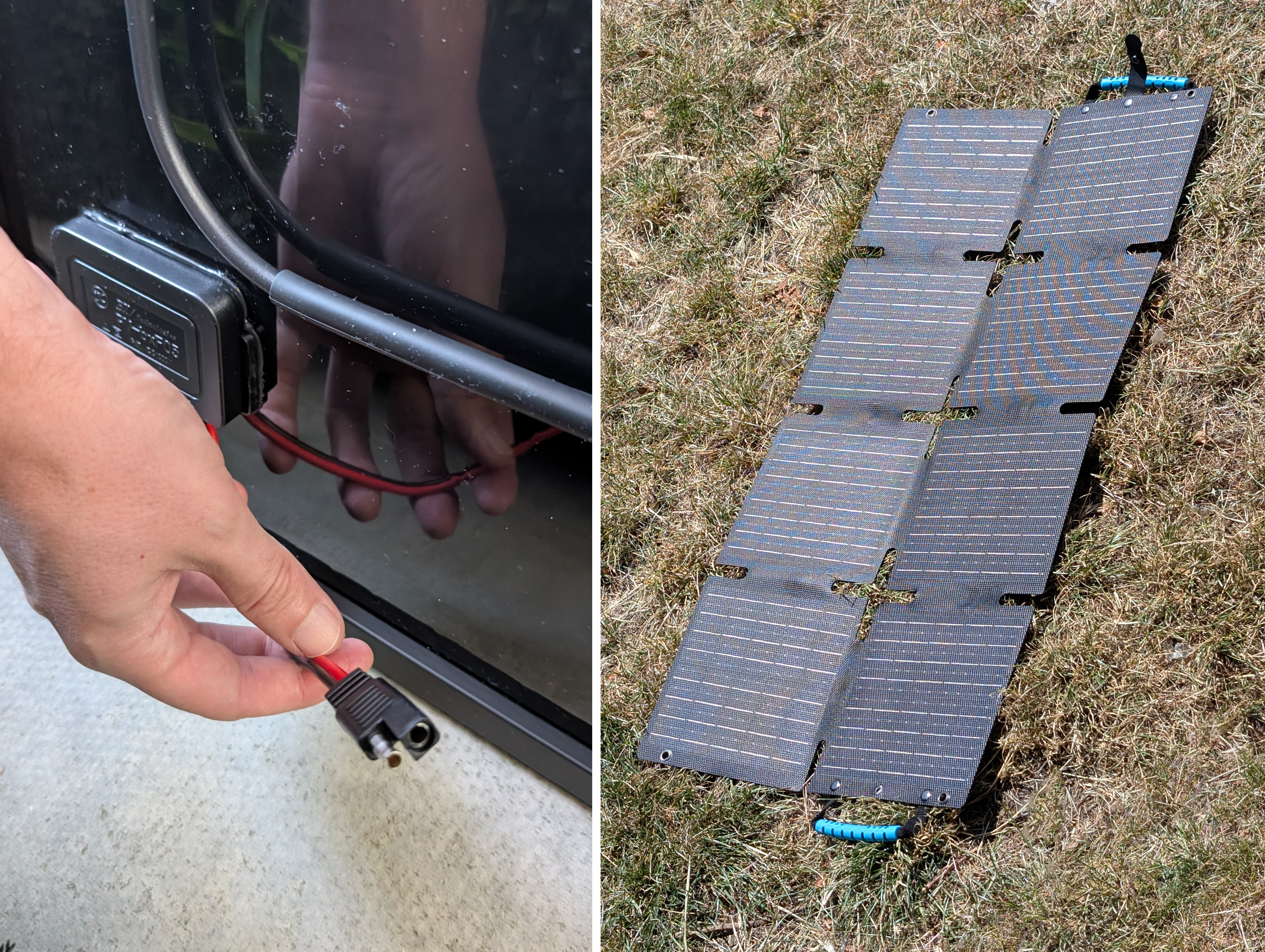
I tested these solar panels and chargers throughout summer, as well as throughout the darker and cloudier days that followed. I tried a range of solar chargers for different uses, from large, fold-out models capable of powering multiple devices at once, to portable power banks with convenient built-in solar panels. I trialled them under the changeable weather conditions in the south of England, including while camping and at a festival.
I assessed these solar panels by several metrics and features:
- Output capacity: Solar panels are rated in watts. The higher the number, the more electricity is generated during a given time period, but the larger the panel will be.
- Surface area: The larger the solar panel, the more sunlight it can collect. This means batteries can charge at faster speeds, or more devices can be charged at once. For this reason, a large surface area is a good option for times when the weather conditions are poor or daylight hours are short.
- Semi-flexible or rigid panels: Flexible solar panels are great for those with limited bag space, as they can be folded up for easy transport. They can also be folded out to form a greater surface area than a rigid model.
- Kickstands: Solar chargers need to be aimed directly at the sun to achieve peak efficiency, with even a slight offset having a big impact on how much power they produce. Look for a solar charger with a kickstand that can be adjusted to any angle, so you can get the positioning just right.
Why you can trust IndyBest reviews
Steve Hogarty is a technology journalist with more than a decade’s experience testing and reviewing the latest gadgets, from smartphones and laptops to e-bikes and electric vehicles. His reviews of solar chargers are designed to measure performance in the real world, taking into account everything from connectivity and features to price and portability, so you can be sure his verdicts are authentic, honest and unbiased.
The best solar chargers for 2025 are:
- Best overall – Bluetti PV60F: £89, Bluettipower.co.uk
- Best budget buy – Forclaz solar panel SLR 500 V2: £34.99, Decathlon.co.uk
- Best for camping – Jackery SolarSaga 100W solar panel: £199.20, Hampshiregenerators.co.uk
- Best for campervans – Ecoflow 220W: £349, Hampshiregenerators.co.uk
- Best fold-out power bank – Addtop solar charger power bank: £34.20, Amazon.co.uk
Best power banks and portable chargers to keep your devices topped up on the go
10 best two-person tents, tested on Highlands hikes
The best camping chairs for kicking back in the great outdoors
12 best travel pillows, tested on flights and train journeys
10 best mosquito repellents to keep bites at bay while home or away
Bluetti PV60F portable solar panel
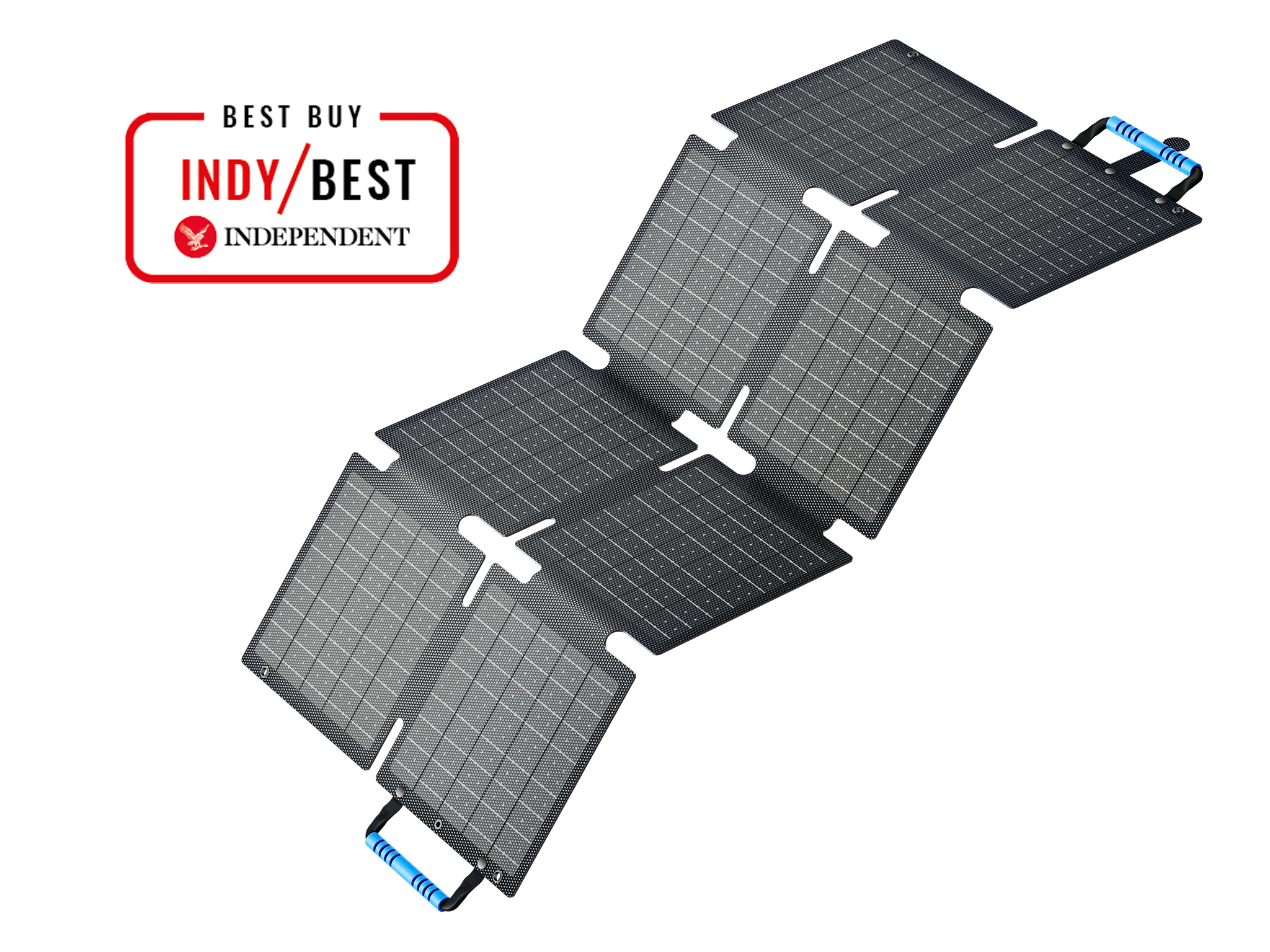
Best: Solar panel overall
Power: 60W
Weight: 1.4kg
Size: 900mm x 424mm
Size (folded): 226mm x 210mm x 70mm
Connections: DC, USB-C, USB-A
Why we love it
- Folds up into compact shape
- Convenient carry-handle and clip
- 60W output
Take note
- No kickstand
The Bluetti PV60F folds down into an impressively neat little square, about the width of a sheet of A4 paper. Unfolded, it expands to a length of 900mm, revealing an array of six monocrystalline silicone panels capable of putting out 60W of power under ideal conditions.
Coupled with its rugged carrying handle, Velcro grips and secure button clip, the size and flexibility of this portable solar panel make it a great choice for taking on camping trips and hikes. Bluetti keeps things compact by not offering a kickstand with the PV60F – it’s an excellent panel when laid flat at midday, but you’ll need to find some way to prop it up against a tent or backpack when the sun starts to drop.
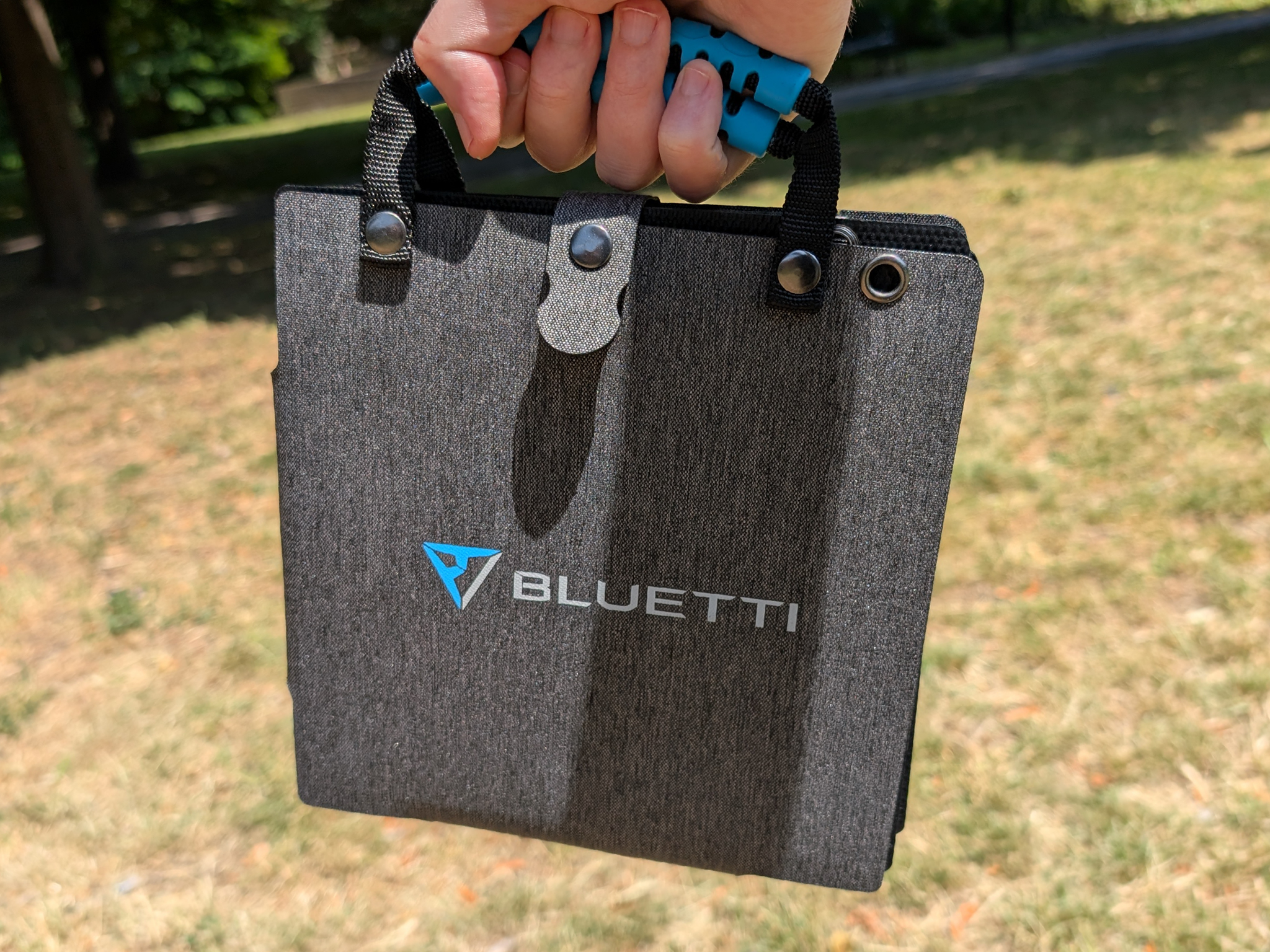
The flexibility and lightness of the folding panels make it a comfortable choice for draping on your back as you hike. Metal eyelets and a tough handle give you a few different ways to secure it where you need it.
You get three connections, including a USB-C and USB-A port for directly charging phones, tablets and laptops in a pinch. There’s also a standard solar DC port for connecting to a portable power station. I tested this model with the AC50B (£269, Bluettipower.co.uk), a 448Wh battery that Bluetti bundles with the PV60F panel.
Buy now £89.00, Bluetti.co.uk
Forclaz solar panel SLR 500 V2, 10W
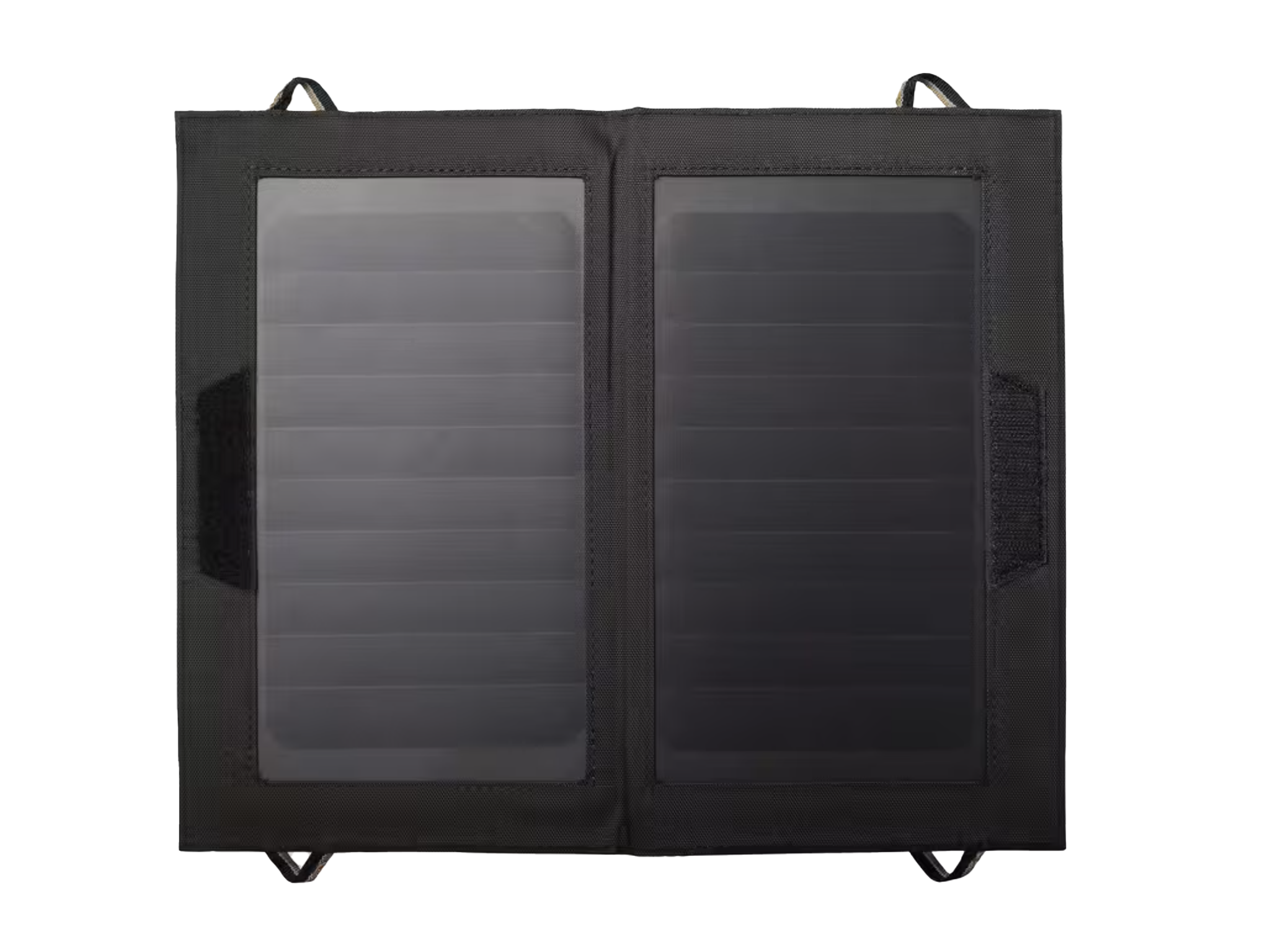
Best: Budget solar panel
Power: 10W
Weight: 285g
Size: 350mm x 290mm x 13mm
Size (folded): 290mm x 180mm x 18mm
Connections: One USB-A
Why we love it
- Packs neatly into pouch
- Great value for money
Take note
- Doesn't deliver as much energy as more-premium options
This is a 10W solar charger with a single USB port, ideal for keeping battery packs topped up while on the move or camping. A respectable power output places this versatile panel somewhere in the middle of the range, delivering more energy than a small trickle charger but less than a larger and more expensive solar panel.
The dual-panel design packs away neatly into a fabric pouch and can be firmly strapped to a backpack with the help of included carabiners and eight anchor points. A reliable charging solution that straddles the gap between low-and-slow panels and more serious hardware, the Forclaz panel suits casual campers and long-distance walkers.
Buy now £34.99, Decathlon.co.uk
Goal zero nomad 20 solar panel
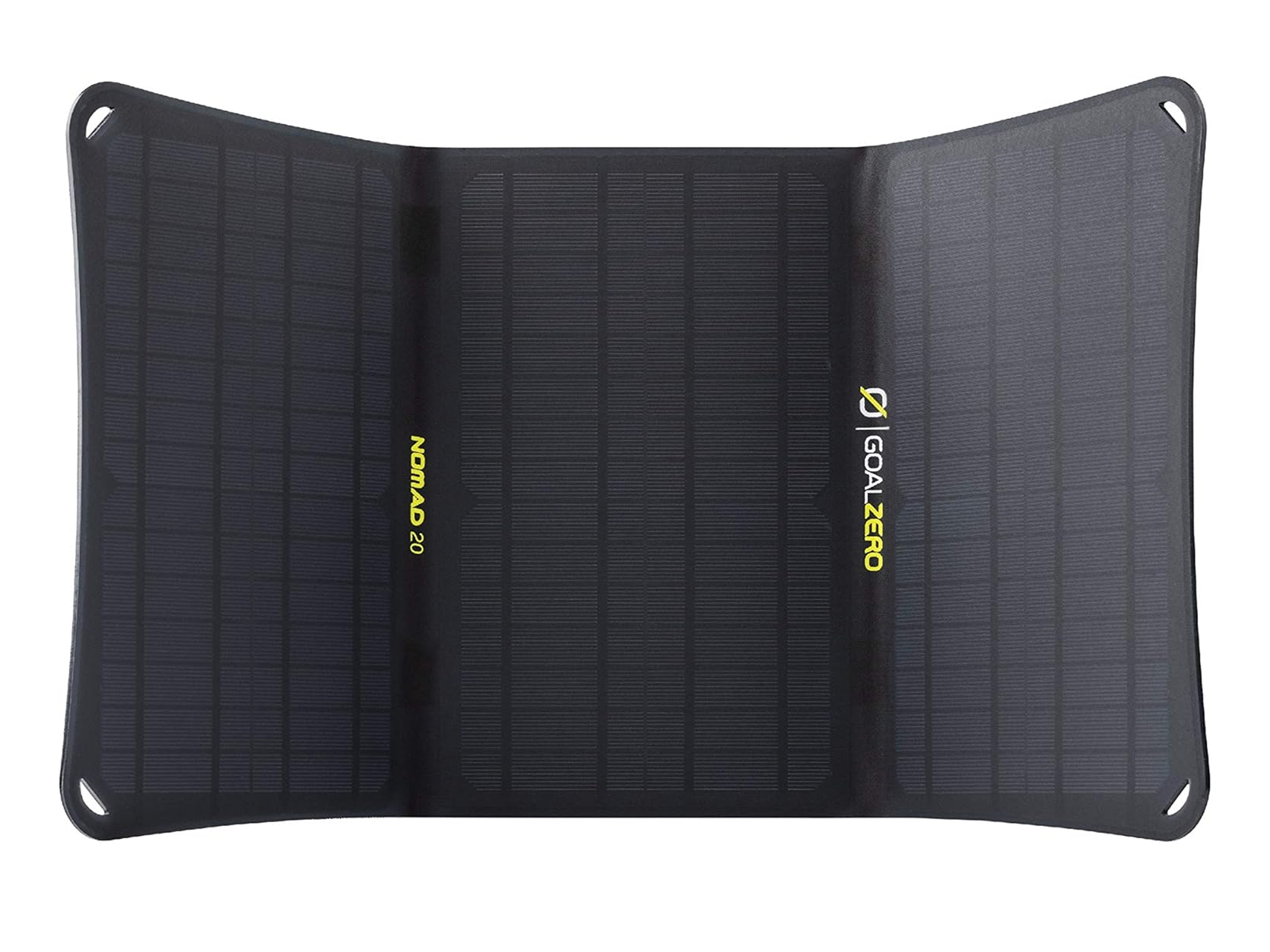
Best: Solar panel for backpackers
Power: 20W
Weight: 1kg
Size: 550mm x 20mm x 290mm
Size (folded): 290mm x 20mm x 32mm
Connections: One USB-A
Why we love it
- Easy attachments
- Flexible USB port
Take note
- Expensive
A flat and highly portable solar charger, this model is designed for backpackers and campers who want to travel light but need something more than a basic 5W panel. Half a metre wide when unfolded and weighing less than a laptop, it has an adjustable kickstand for aiming it directly towards the sun when placed on the ground. The rugged plastic frame has an attachment point on each corner, so you can strap it to a backpack or secure it firmly in place wherever it needs to be.
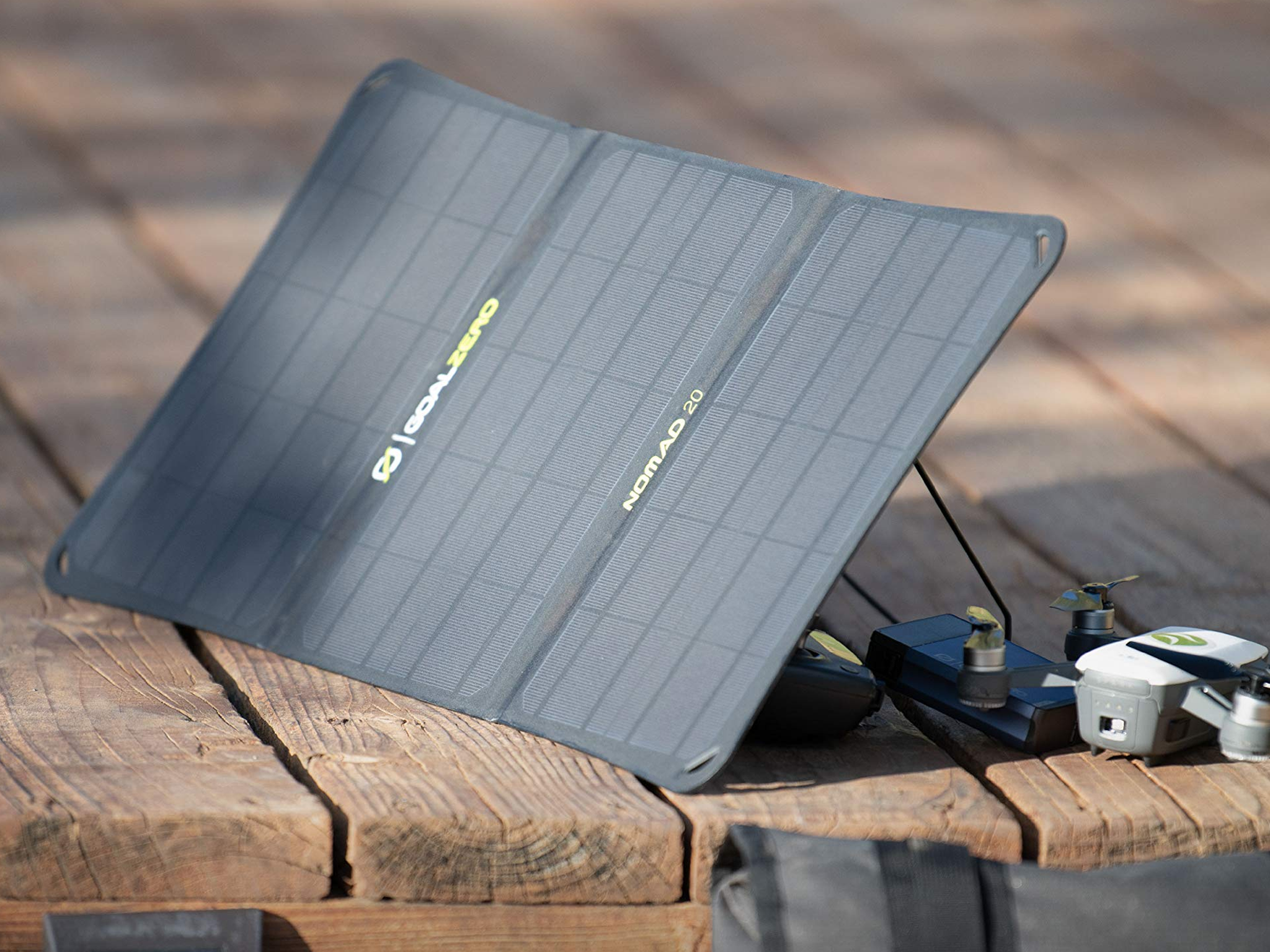
I liked that the USB output is on a lightly flexible arm, which helps prevent wear and tear on your charging cables. You can also chain multiple panels together with the included 6-foot-long chaining cable to speed up charging.
Buy now £179.99, Goalzero.co.uk
Jackery SolarSaga 100W solar panel
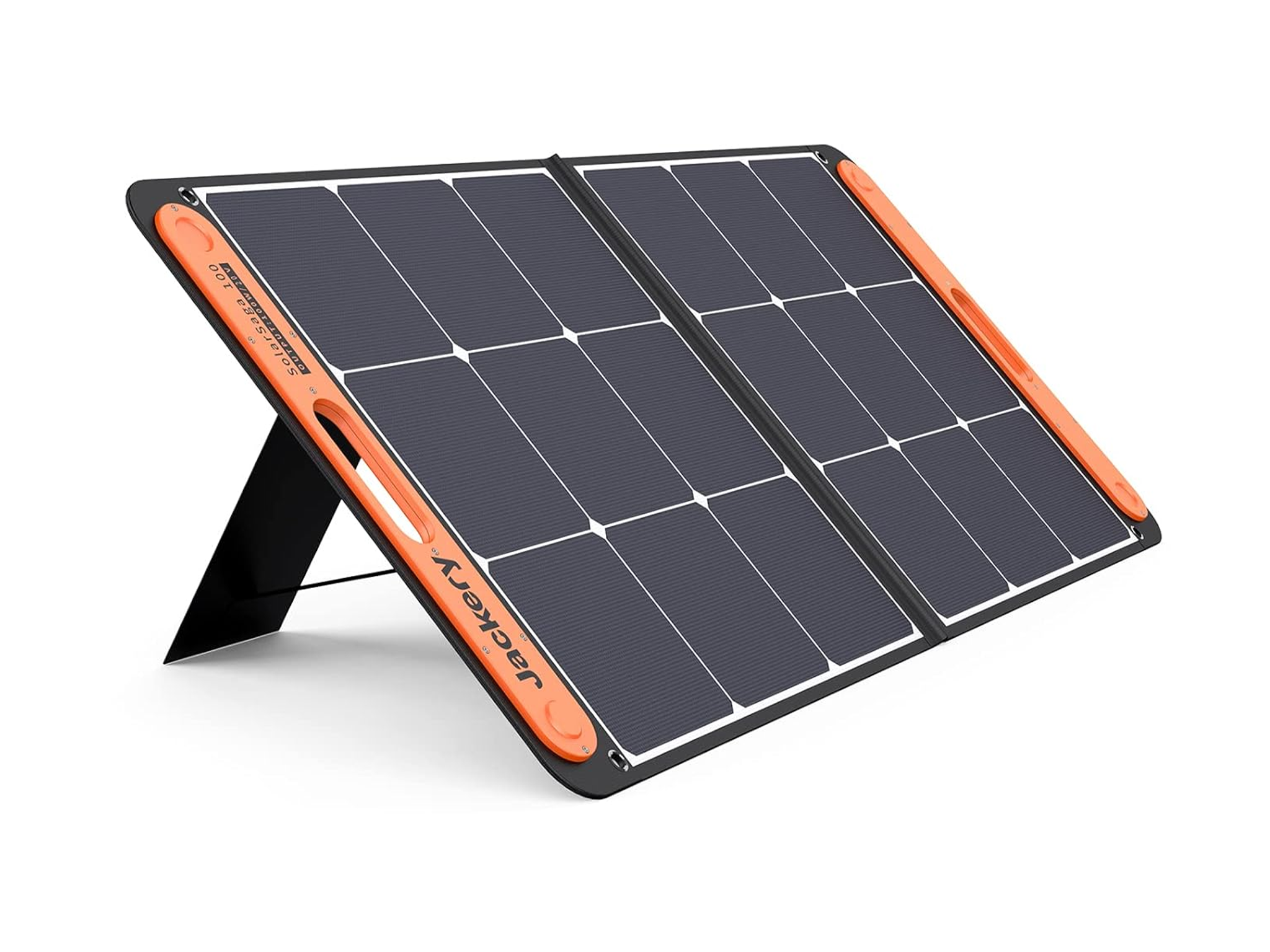
Best: Solar panel for camping
Power: 100W
Weight: 4.68kg
Size: 122cm x 0.5cm x 53cm
Size (folded): 60cm x 1cm x 52cm
Connections: 1x USB-A, 1x USB-C, Anderson to power station
Why we love it
- Packs away neatly
- Can charge power stations and devices
Take note
- Not weatherproof
- The kickstand isn't the sturdiest
This model is designed to work with the Jackery power station, which is mainly how I tested it, but it can easily be operated solo, too. The relatively high wattage and variable output of the panel mean it’s better suited to recharging a small power bank, which you would then use to charge your devices, rather than plugging your phone or laptop directly into it. That’s good news for anyone who travels light and doesn’t want to lug the heavy Jackery power station around with them.
The foldable panel itself is exceptionally well made, snapping shut magnetically and featuring a comfortable carry handle for safe transport and setup. The kickstand can be adjusted to any angle to get the most efficient performance possible, though the lightweight construction leaves it prone to falling over in windy conditions. There are also reinforced eyelets and loops to secure it. The panel isn’t waterproof, so I advise against leaving it outside the tent overnight.
Buy now £199.20, Hampshiregenerators.co.uk
Ecoflow 220W solar panel
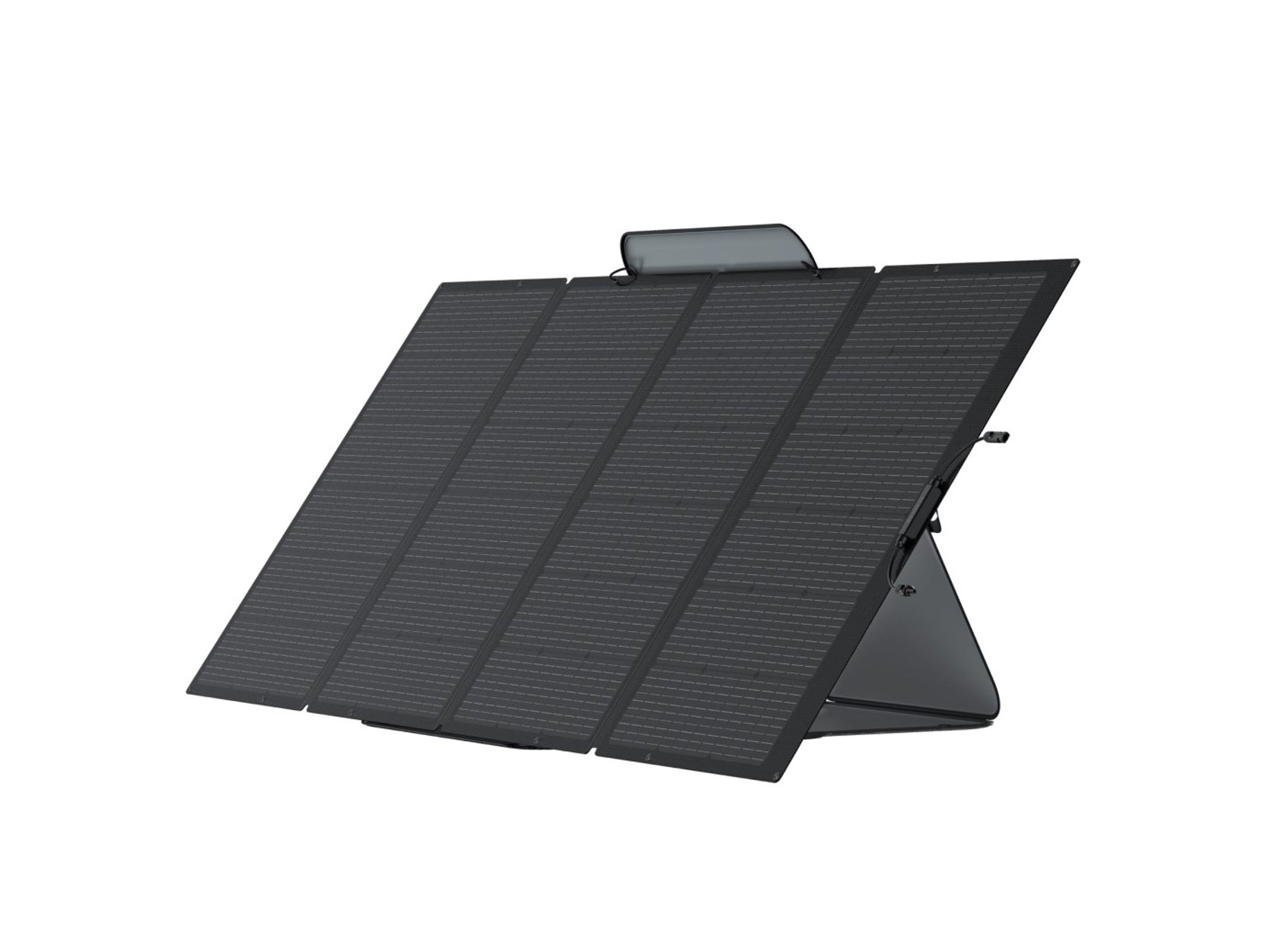
Best: Solar panel for campervans
Power: 220W/155W
Weight: 538g
Size: 183cm x 82cm x 2.5cm
Size (folded): 50cm x 82cm x 3.2cm
Connections: MC4 solar port
Why we love it
- Delivers lots of power
- Bifacial design
Take note
- Not very portable
This solar panel produces roughly 10 times the wattage of the next best entry in my list, in terms of power. This does make it less portable, but also way more useful for charging the specialist batteries needed to power small appliances at campsites; off-grid rental lodges; caravans; and emergency home backup should your electricity ever fail.
The solar panel is bifacial, meaning it’s got a second 155W panel on the reverse side. This enables it to pick up a small amount of bonus current by absorbing some ambient light in bright conditions, which creates a more even power distribution during changeable weather conditions and so less wear on the device it’s charging.
We tested the 220W panel with Ecoflow Delta power station, a 14kg beast of a battery that features four USB-A ports (two fast-charging), two USB-C ports and four three-pin plug sockets. The station can be slow-charged by solar panel, or by mains power in less than two hours.
Buy now £349.00, Hampshiregenerators.co.uk
BioLite solar panel with integrated power pack
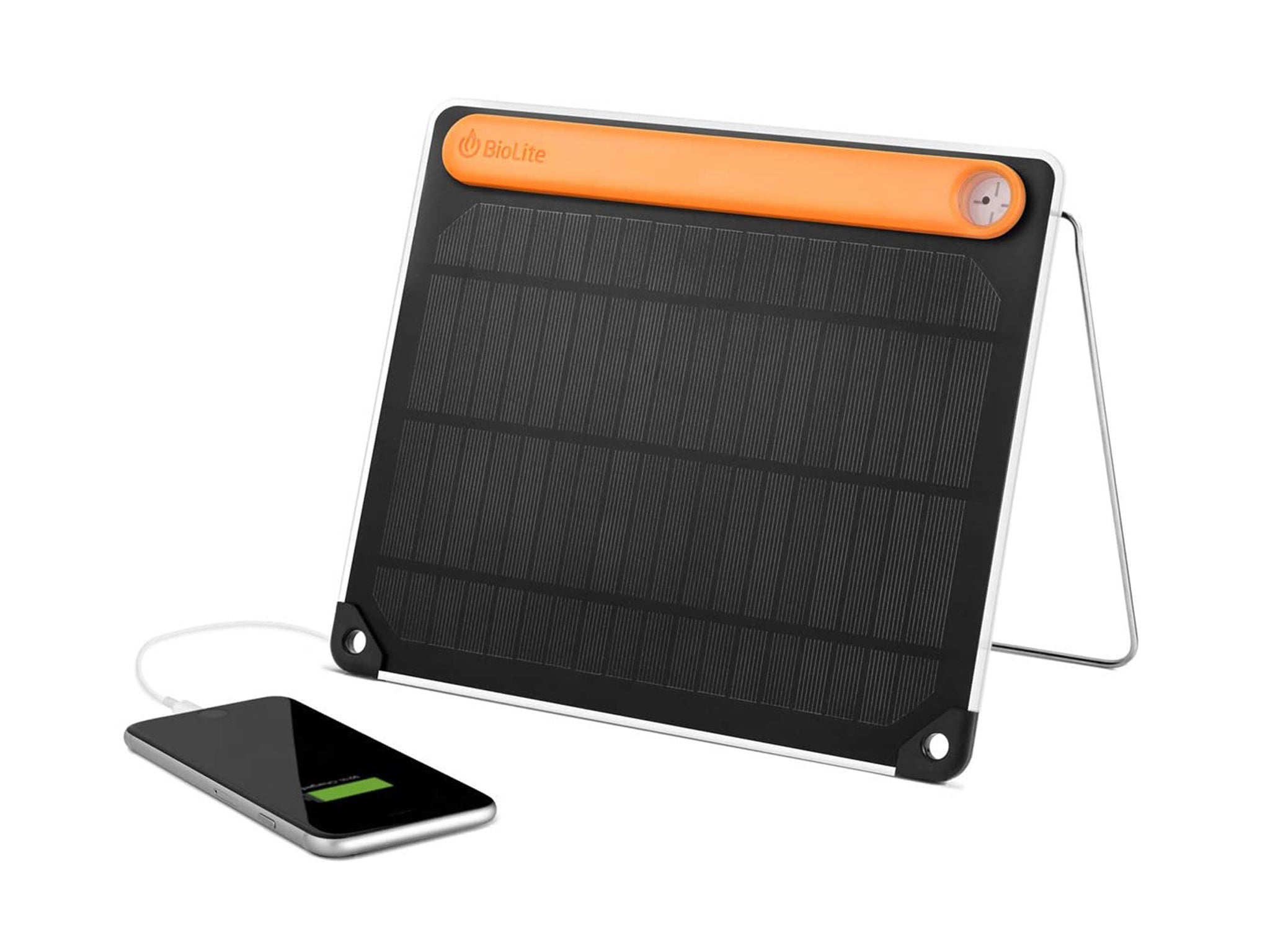
Best: Solar panel for charging phones
Power: 5W
Weight: 390g
Size: 286mm x 39mm x 229mm
Size (folded): N/A
Connections: One USB-A
Why we love it
- Helpful alignment tool
- Thin and lightweight
Take note
- Just one port
This ultra-thin 5W solar panel is an all-in-one solution and, unlike other solar chargers in my list, has an integrated 2,200mAh battery pack embedded on the back. That’s about enough to charge your phone once, which is all you need in an emergency.
It has a simple wire-loop kickstand that can be threaded through a backpack strap, hooked from a tree branch or used to prop the panel up on the ground. Eyelets on the bottom corners also prevent it from sliding out of the sunlight as you walk. I liked the incredibly simple sundial on the corner of the device, which enables you to accurately aim the panel directly into the sunlight for maximum efficiency.
Buy now £85.00, Gooutdoors.co.uk
BigBlue 3 USB ports 28W solar charger
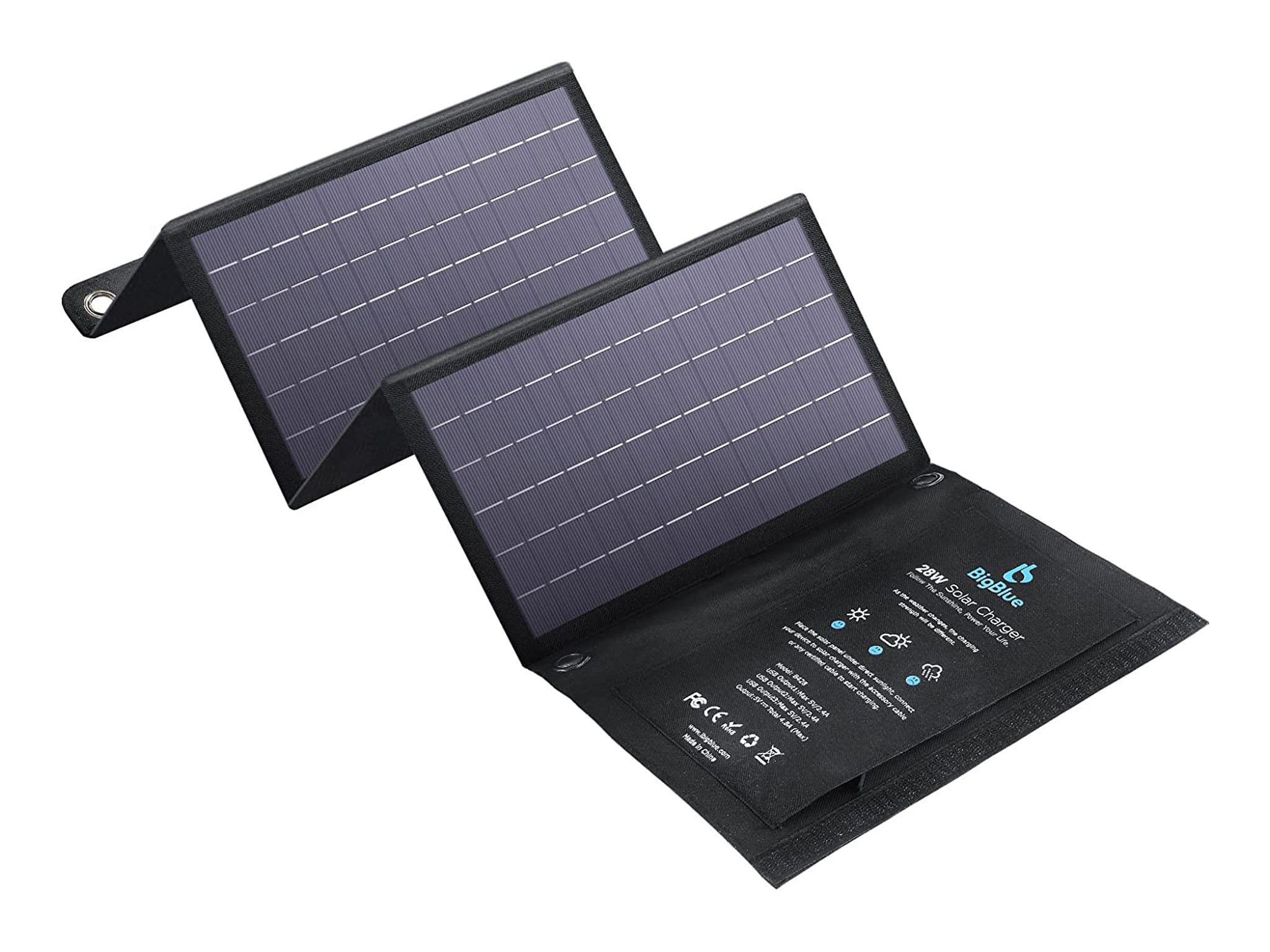
Best: Solar panel for multiple devices
Power: 28W
Weight: 1.2kg
Size: 1,030mm x 280mm x 5mm
Size (folded): 280mm x 190mm x 40mm
Connections: Three USB-As
Why we love it
- Camping and hiking attachments
- Can hang from tents and backpacks
Take note
- No kickstand
A folding solar charger with 28W output in optimal skies, this four-panel design can recharge three low-draw, 5V devices at the same time, through its three USB-A ports. Powerful enough to slow-charge tablets and other high-drain mobile devices, this solar charger has a flexible design that’s useful for hanging from your back as you walk, from your tent as you camp, or from a window frame for household power (it comes with carabiners for attaching it to a rucksack or frame). However, it lacks a kickstand.
Buy now £68.99, Amazon.co.uk
Addtop solar charger power bank
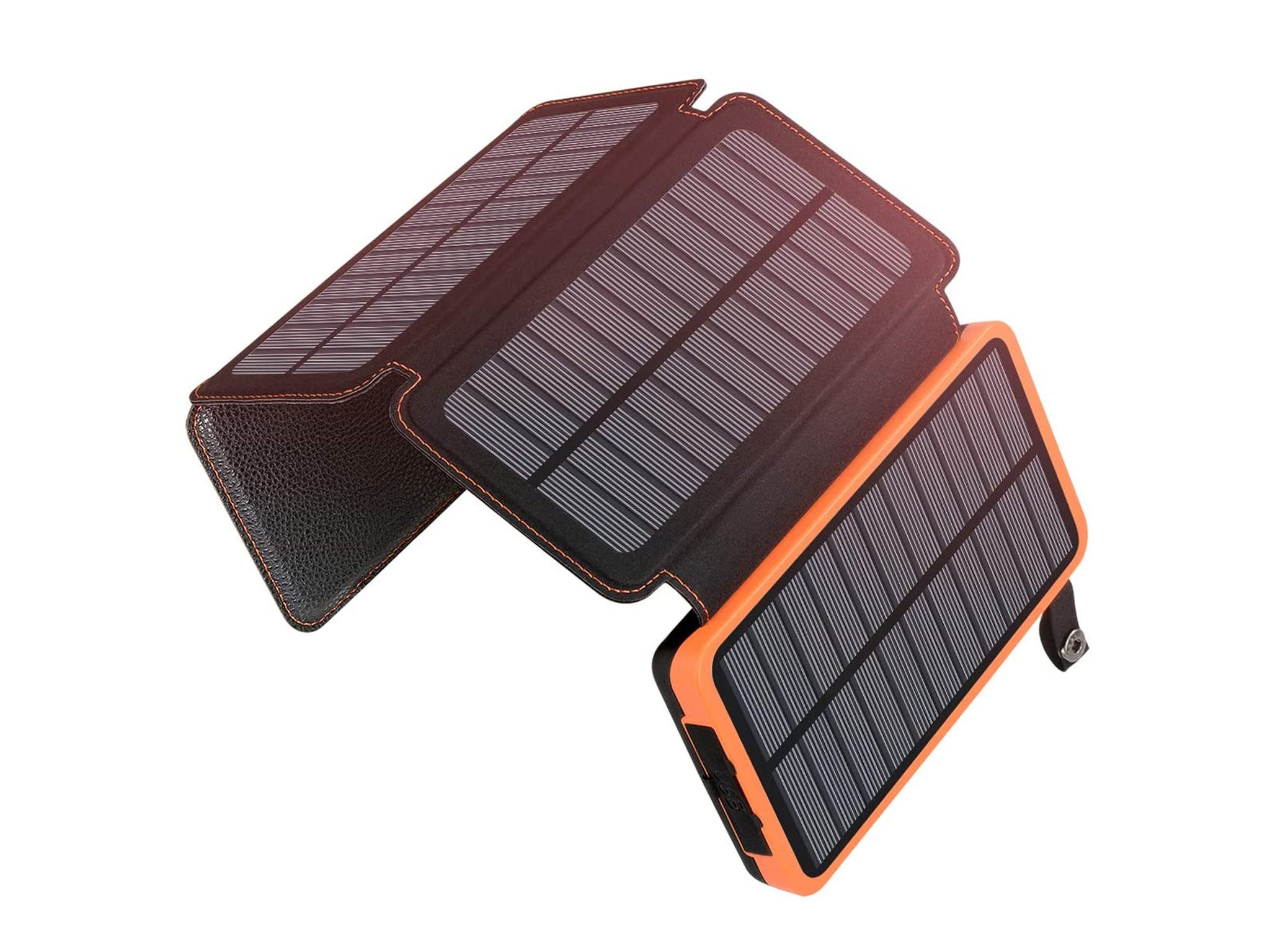
Best: Fold-out powerbank solar panel
Power: 5W
Weight: 538g
Size: 154mm x 90mm x 35mm
Size (folded): 154mm x 360mm x 9mm
Connections: Three USB-As
Why we love it
- It is its own battery pack
Take note
- Very slow charging in sunlight
This is a 25,000mAh battery pack with a fold-out four-panel solar cell, which produces enough photonic juice to trickle-charge the pack’s power reserves over time. These super-portable chargers are limited by physics (that old killjoy), so don’t expect the dinky panels to kick out enough energy to be able to run a laptop or survive entirely off-grid. They’ll charge the battery pack to full, given a few days of bright, sunny weather.
Still, if you’re after a rugged outdoor power bank with a built-in LED torch that can top itself up in the background while you’re setting up camp and wrestling bears, this is a convenient and useful little gadget to have in your pack.
Buy now £34.20, Amazon.co.uk
Halfords 10W solar power battery maintainer
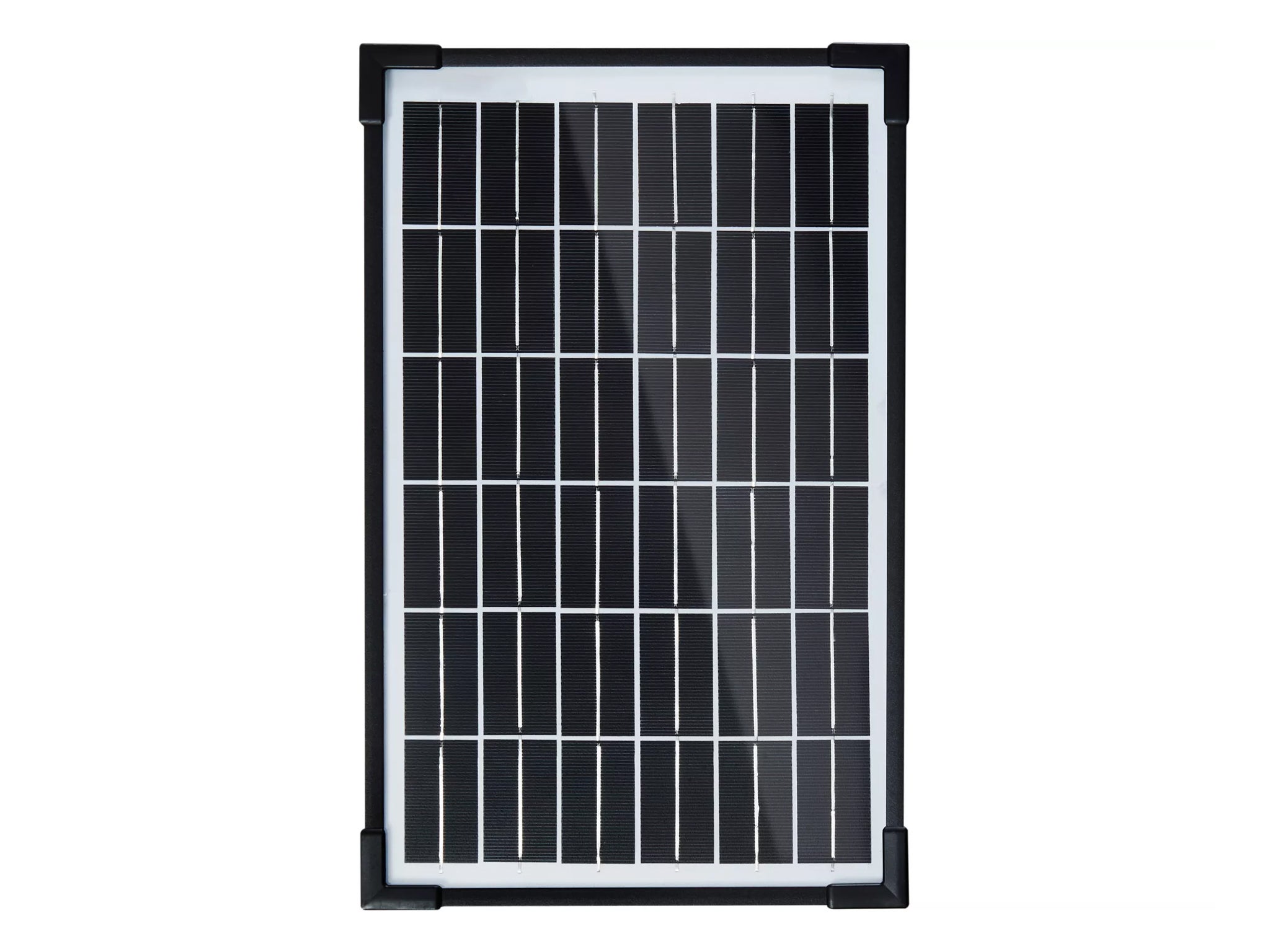
Best: Solar panel for car batteries
Power: 10W
Weight: Unspecified
Size: 400mm x 200mm x 17mm
Size (unfolded): N/A
Connections: 12V, DC power plug and battery clips
Why we love it
- Easily affixed to windshield
- Comes with required clips
Take note
- Not designed for travelling
If your car battery has a tendency to run dry when left idle for too long, you need a solar-powered car-battery maintainer. Even in the sun-averse British weather, a solar panel affixed to the inside of your windscreen can trickle enough charge into the battery to keep it refreshed and ready to go.
This 10W solar charger can be placed inside your car, but it’s waterproof and durable enough to be positioned outside for better efficiency. It clamps directly to the battery using crocodile clips or can deliver a charge via your cigarette lighter if the car’s electrics allow. One downside is that the basic design means there’s no interface or status light to confirm if any charging is happening, so if you want to be absolutely sure it’s working, you’ll need to use a multimeter to double-check your car battery level.
The power output is rated for charging larger batteries, too, such as those found on boats, barges and trucks.
Buy now £31.49, Halfords.com
Osram BatteryCharge Solar 100W
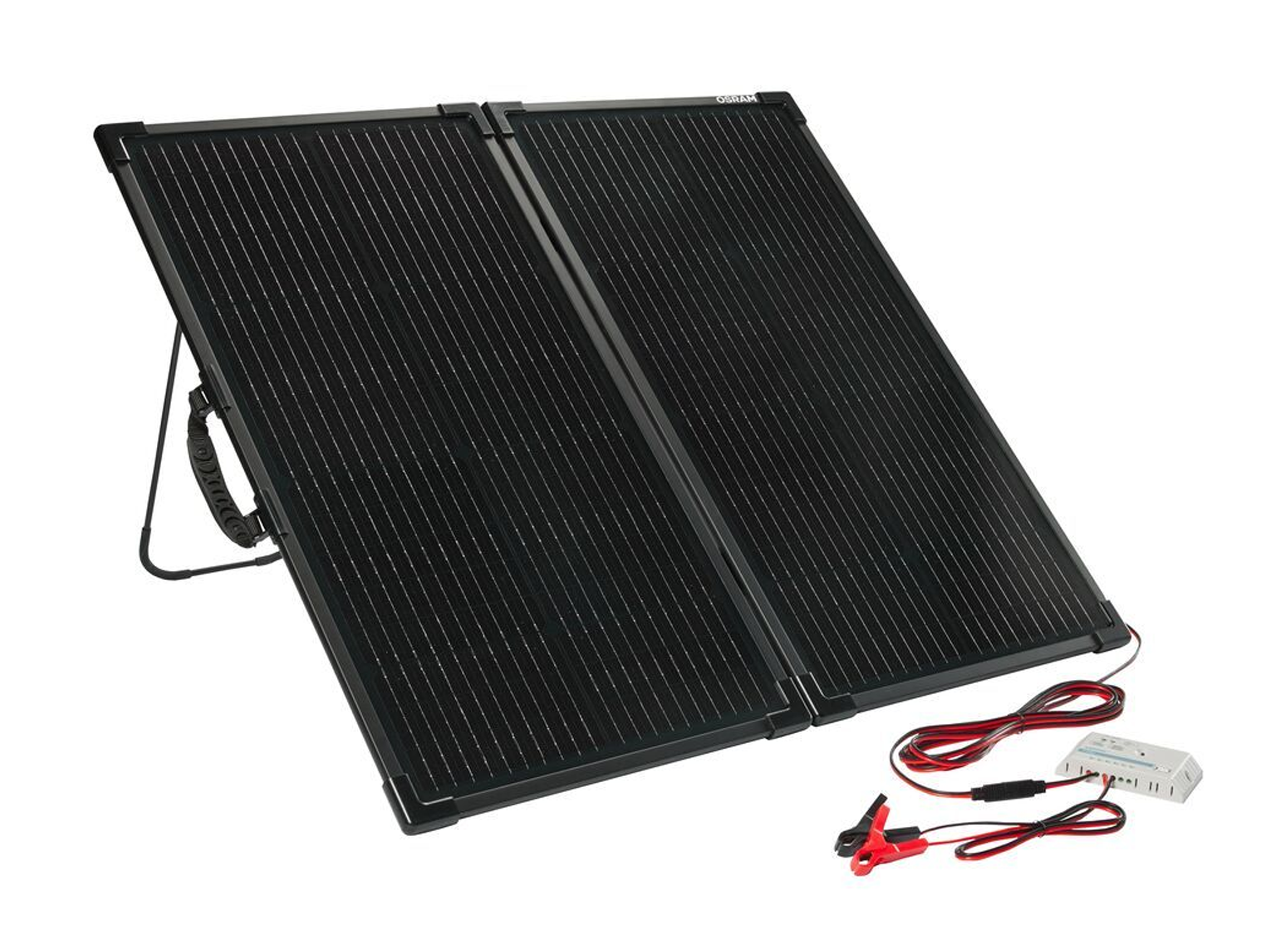
Best: Solar panel for 12V battery chargers
Power: 100W
Weight: 8kg
Size: 530mm x 557mm x 40mm
Size (folded): 530mm x 230mm x 80mm
Connections: 12V battery clips, USB-A
Why we love it
- Powerful 100W output
- Good outdoor durability
- Charge controller included
Take note
- Not very mobile
Another portable solar panel designed for charging and maintaining 12V batteries, this panel is ideal for keeping caravans, campervans, car batteries and barges from running flat.
With up to 100W of power coming from the 550mm square panel, it can bring a dead battery back to life, too – unlike some weaker battery maintainers. The 12V/10A charge controller prevents overcharging and gives you an indication of progress, and there’s a USB-A output if you need to top up your phone.

The single-fold design uses a robust aluminium frame for outdoor durability, with IP65 water and dirt resistance, keeping the panels safe should the weather suddenly switch from sunny to miserable. The panels also come in an easy-to-carry nylon case, to prevent damage.
Buy now £149.00, Ringautomotive.com
Your questions on solar chargers answered
Which is the best solar charger?
The Bluetti PV60F is my pick of the best portable solar panels. Though it lacks a kickstand, its flexibility and compact folded size makes it a great choice for camping and hiking. It’s powerful and versatile, with a 60W output and wide compatibility with USB-C, USB-A and portable power stations.
For more static sites, you might want to consider the Goal Zero nomad 20. It can be more easily angled and offers everything you might need in a solar charger: high wattage, an abundance of USB ports, a business-like folding design and the leading monocrystalline panel type. For mains-style power output on demand, the Ecoflow portable power station and 220W panel is highly recommended.
How long do solar chargers last?
Solar cells deteriorate over time. While performance varies from model to model, most are rated to maintain 99 per cent efficiency for more than three years, with some of the more premium designs claiming to last an impressive 25 years.
Do solar chargers work through a window?
Yes, but the amount of energy harvested by the panel will be greatly reduced, especially if the glass is tinted or has UV light-blocking properties. According to Sol Volatics, a website that provides advice on solar panel installations, the efficiency of a panel can be reduced by up to 50 per cent, depending on the thickness and cleanliness of the glass.
What are the best uses for solar chargers?
Portable solar chargers are best used to power small electrical items, such as smartphones and portable battery packs. They can be perfect for topping up the batteries of devices you might take on a camping trip, but generally aren’t much help when it comes to feeding more power-hungry products, such as televisions, portable fridges and kettles.
Some portable solar panels, such as the Ecoflow 220W (£349, Hampshiregenerators.co.uk) highlighted in this article, cost much more than others, are significantly larger, and therefore will harvest more energy. Such panels can, eventually, fill up an equally large portable battery pack capable of running anything with a domestic three-pin plug, but how quickly the battery charges will depend on weather conditions and how much sunlight the solar panel is exposed to.
Phones and laptops prefer a consistent flow of energy, but the power output of solar panels varies based on weather conditions and the angle of the sun. Some phones will refuse to charge from a panel that’s fluctuating in output, so it’s always best to use the panel to recharge a portable power bank first, then charge your devices from that.
Will using a solar charger save me money?
A solar charger can technically save you money, though you’d need to recharge your devices a lot just to break even on using a solar charger at home. The power output of portable panels simply isn’t very high – it’s more than enough to charge electronics, but not enough to run appliances or heat tanks of water. Those energy-intensive jobs are where most of your electricity is used, so a portable solar panel will hardly make a dent in your household bills.
What are the alternatives if there is no sunlight?
Obviously, solar panels don’t work without sunlight to power them. If you live somewhere with reduced or no sunlight during the winter months (which includes the UK and parts of North America), you’ll see a dramatic downturn in solar panel energy output when the sun is low in the sky.
To supply electricity in a remote area with little sunlight, you’ll either need a very large battery pack to store up what little solar energy is available or a fully fuelled diesel generator. The latter is by far the cheapest way of powering remote sites or an entire home, and, to deal with emergencies, they can be set up to kick into action in the event of power loss.
Want more recommendations? We’ve rounded up the best phones to buy right now

